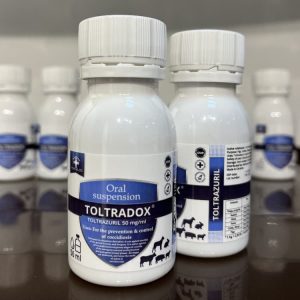When it comes to the health and well-being of our canine companions, staying informed about effective treatments is essential. One such potent tool in the battle against coccidiosis, a common parasitic disease in dogs, is Toltrazuril. In this article, we’ll delve into the benefits and applications of toltrazuril for dogs, understanding how this medication can make a significant difference in their lives.
Understanding Coccidiosis
Coccidiosis is caused by the Cystoisospora species, also known as Isospora. This parasitic infection can lead to severe gastrointestinal distress, including diarrhea, vomiting, dehydration, weight loss, and lethargy. Young puppies and immunocompromised dogs are particularly susceptible to severe manifestations of the disease. Prompt and effective treatment is crucial to alleviate their suffering and prevent potential complications.
Before we explore the wonders of toltrazuril, let’s grasp the seriousness of coccidiosis. This intestinal infection, caused by the coccidia parasite, affects dogs of all ages, particularly puppies. Common symptoms include diarrhea, lethargy, and weight loss, posing significant risks to your furry friend’s health.
Coccidiosis is a parasitic disease caused by the Coccidia species, which are intracellular parasites that primarily target the gastrointestinal tract of dogs. These microscopic organisms can be ingested through contaminated food, water, or contact with infected feces. Once inside the dog’s system, the parasites undergo several stages of development, leading to tissue damage and gastrointestinal distress.
Young puppies are particularly vulnerable to severe manifestations of coccidiosis, as their immune systems are still developing. Puppies can acquire the infection from their mother’s milk or through the environment.
Coccidia Infections are often Spread in Kennels
In kennels or other crowded environments, the risk of exposure to the coccidia parasite is higher, making preventive measures and early detection crucial in managing the infection.
The most common symptom of coccidiosis is diarrhea, which may range from mild to severe. Diarrhea may be watery, mucoid, or contain blood, depending on the severity of the infection. Puppies may become dehydrated and lethargic due to fluid loss, and their appetite may decrease, leading to weight loss. In severe cases, untreated coccidiosis can have serious health implications, especially in young and immunocompromised dogs.
As responsible pet owners, it is essential to stay vigilant for any signs of gastrointestinal distress in our canine companions. If your dog exhibits symptoms such as diarrhea, vomiting, lethargy, or changes in appetite, it is crucial to seek immediate veterinary attention for proper diagnosis and treatment.
Toltrazuril is extremely effective Solution in Treating Coccidiosis
Fortunately, the availability of effective medications like toltrazuril offers hope in combating coccidiosis. Toltrazuril, a potent antiprotozoal medication, has demonstrated impressive efficacy against Coccidia parasites, providing much-needed relief to affected dogs.
Toltrazuril exerts its mechanism of action by selectively paralyzing the nervous system of these protozoa. By disrupting the energy-producing structures within the parasites, the medication ultimately leads to their elimination from the dog’s gastrointestinal tract.
One of the significant advantages of using toltrazuril for coccidiosis is its broad-spectrum efficacy. Besides Coccidia species, toltrazuril has also been effective against other protozoal parasites, making it a versatile and powerful treatment option in veterinary medicine.
When administered at the appropriate dosage, toltrazuril is generally well-tolerated by dogs. Most dogs experience minimal to no side effects, and any observed reactions are usually mild and transient. However, as with any medication, individual dogs may react differently, and it is essential to consult with a veterinarian before administering toltrazuril.
To ensure the best possible outcomes, pet owners should never attempt to self-diagnose or self-medicate their dogs with toltrazuril or any other medication. Veterinary guidance is crucial in accurately diagnosing coccidiosis and determining the most appropriate treatment plan.
Puppies Contracting Coccidia: Understanding the Modes of Transmission and Preventive Measures
Coccidia is a parasitic infection caused by protozoa from the Coccidia species. While it can affect dogs of all ages, puppies are particularly susceptible to this gastrointestinal disease. Understanding how puppies contract coccidia is crucial for pet owners and breeders to implement preventive measures and ensure the health and well-being of these young and vulnerable canine companions.
Ingestion of Infective Oocysts
The primary mode of transmission of coccidia to puppies is through the ingestion of infective oocysts. Oocysts are microscopic eggs shed in the feces of infected dogs. These oocysts can contaminate the environment, such as the soil, grass, and surfaces where infected feces have been deposited. Puppies can accidentally ingest these infective oocysts while exploring their surroundings, licking contaminated surfaces, or consuming contaminated water or food.
Infected Mother to Puppies
Puppies can also contract coccidia from their mother. A pregnant or nursing mother dog infected with coccidia can pass the parasite to her puppies through the placenta during gestation or through her milk during nursing. This vertical transmission can result in puppies being born already infected with the parasite or becoming infected shortly after birth.
Crowded Living Conditions
Puppies kept in crowded and unsanitary environments, such as breeding facilities, kennels, or animal shelters, are at a higher risk of contracting coccidia. The close proximity and shared living spaces among multiple dogs facilitate the spread of infective oocysts. Contaminated surfaces and shared food and water bowls can contribute to the transmission of the parasite within the group.
Stress and Weakened Immune System
Stress and a weakened immune system can make puppies more susceptible to coccidia infection. Events such as weaning, transportation, or changes in the environment can stress young puppies, making them more vulnerable to parasitic infections. A weakened immune system can also make it harder for the puppy’s body to fend off the invading coccidia parasites.
Preventive Measures
Preventing coccidia infection in puppies requires diligent care and attention to hygiene and overall health. Here are some preventive measures to consider:
Regular Veterinary Check-ups
Scheduling regular veterinary check-ups for puppies is essential to monitor their health and promptly detect any signs of illness or parasitic infections. Veterinarians can perform fecal examinations to identify the presence of coccidia or other parasites, allowing for early intervention.
Proper Hygiene Practices
Maintaining a clean and hygienic living environment is crucial in preventing coccidia transmission. Regularly clean and disinfect living areas, including bedding and toys. Promptly remove and dispose of feces from the environment to reduce the risk of infective oocysts contaminating the surroundings.
Avoid Crowded and Unsanitary Environments
When acquiring a puppy, choose reputable breeders or rescues that prioritize the health and well-being of their animals. Avoid purchasing puppies from crowded or unsanitary breeding facilities or pet stores where the risk of coccidia transmission may be higher.
Quarantine and Testing
If introducing a new puppy into a household with other dogs, consider quarantining the new addition for a short period. This allows for observation and testing for any underlying parasitic infections before allowing close contact with other dogs.
Deworming and Medication
Following the guidance of a veterinarian, administer appropriate deworming medications to puppies to target and eliminate coccidia and other intestinal parasites. Proper dosage and treatment protocols are essential for effective parasite control.
The Difficulty with Diagnosing Coccidia: Unraveling the Challenges in Identifying a Stealthy Parasite
Despite their tiny size, coccidia can wreak havoc on a dog’s gastrointestinal system, leading to diarrhea, vomiting, dehydration, and potential complications, especially in young puppies and immunocompromised dogs. However, diagnosing coccidia can be a challenging task for veterinarians and pet owners alike, as the parasite’s stealthy nature often evades detection.
Microscopic Size and Low Oocyst Shedding
Coccidia oocysts, the microscopic eggs shed in the feces of infected animals, are small and difficult to detect without the aid of specialized equipment, such as a microscope. Additionally, infected dogs may not always shed a significant number of oocysts in their feces, especially during the early stages of infection. As a result, a single fecal examination may not always yield a positive diagnosis, leading to potential false-negative results.
Intermittent Shedding
The shedding of coccidia oocysts can be intermittent, meaning that an infected dog may not shed oocysts consistently in every fecal sample. This intermittent shedding pattern can further complicate the diagnostic process, as multiple fecal examinations may be necessary to increase the chances of detecting the parasite.
Overlapping Symptoms with Other Conditions
The clinical signs of coccidiosis, such as diarrhea, vomiting, and lethargy, are non-specific and can overlap with symptoms of other gastrointestinal disorders. This similarity in symptoms makes it challenging to distinguish coccidiosis from other causes of gastrointestinal distress, such as viral infections, bacterial enteritis, or dietary indiscretions. A thorough evaluation and diagnostic workup are necessary to rule out other potential causes and pinpoint the underlying issue accurately.
Coinfections and Mixed Infections
Dogs can be affected by multiple parasites simultaneously. Coinfections or mixed infections, where coccidia coexist with other gastrointestinal parasites, can occur in some cases. Identifying coccidia in the presence of other parasites can be complex, requiring more comprehensive diagnostic approaches.
Timing of Fecal Examination
The timing of fecal examination is critical in diagnosing coccidia. Early in the course of infection, oocyst shedding may be low or absent, resulting in false-negative results. It is essential to perform fecal examinations at appropriate intervals and consider multiple samples to improve the likelihood of detecting the parasite.
Stress-Induced Shedding
Stress can play a role in coccidia oocyst shedding. Puppies or dogs experiencing stress, such as during transportation, boarding, or changes in their environment, may have increased oocyst shedding. This stress-induced shedding can make it difficult to differentiate active infections from transient oocyst shedding without clinical significance.
Infections in Asymptomatic Dogs
Some dogs may carry coccidia without showing any clinical signs of coccidiosis. These asymptomatic carriers can act as reservoirs of infection, potentially spreading the parasite to other dogs without being identified through routine clinical evaluations.
How to Administer Toltrazuril: A Guide to Safely and Effectively Treat Coccidiosis in Dogs
Administering Toltrazuril correctly is essential to ensure safe and effective treatment and help our canine companions recover from this gastrointestinal disease. Here’s a comprehensive guide on how to administer toltrazuril to dogs.
Veterinary Guidance and Diagnosis
Before administering any medication, including toltrazuril, it is crucial to seek veterinary guidance. A qualified veterinarian can accurately diagnose coccidiosis through fecal examination and determine if toltrazuril is the appropriate treatment for the dog’s condition. The veterinarian will also prescribe the correct dosage and provide instructions for administration.
Determine the Correct Dosage
Toltrazuril dosage for dogs is typically weight-based, meaning it is calculated based on the dog’s body weight. The recommended dosage range is generally between 10 to 20 mg per kilogram (mg/kg) of body weight. The specific dosage within this range will depend on the severity of the coccidiosis infection and the dog’s individual characteristics. The veterinarian will calculate the appropriate dosage and provide this information to the pet owner.
Select the Appropriate Formulation
Toltrazuril is available in various formulations, including oral solutions, suspensions, and tablets. The veterinarian will prescribe the specific formulation that best suits the dog’s needs. It is essential to use the prescribed formulation and follow the dosing instructions carefully.
Administer as a Single-Dose Treatment
In most cases, toltrazuril is administered as a single-dose treatment. This means that the entire prescribed amount of medication is given to the dog at once. The one-time administration simplifies the treatment process and ensures that the medication effectively combats the coccidia parasites.
Oral Administration
Toltrazuril is typically administered orally, either directly into the dog’s mouth or mixed with a small amount of food to encourage consumption. If using a liquid formulation, a syringe or dropper can be helpful in accurately measuring and delivering the correct dosage. For tablets, they can be hidden in a treat or pill pocket to make administration more comfortable for the dog.
Monitor and Observe
After administering toltrazuril, it is essential to monitor the dog closely for any adverse reactions or changes in behavior. While toltrazuril is generally well-tolerated, some dogs may experience mild gastrointestinal upset, such as vomiting or diarrhea. If any unusual or severe reactions are observed, pet owners should contact their veterinarian immediately.
Compliance and Follow-Up
Compliance with the prescribed treatment plan is crucial for successful outcomes. Administering the full course of toltrazuril as directed by the veterinarian ensures that the coccidia parasites are effectively eliminated from the dog’s system. Additionally, follow-up fecal examinations may be recommended to confirm the eradication of the parasites and assess the dog’s recovery.
Store Medication Properly
It is essential to store toltrazuril and any other medications out of reach of children and pets. Follow the manufacturer’s guidelines for proper storage conditions, such as keeping the medication in a cool, dry place and away from direct sunlight.
Toltrazuril Dosage for Dogs: Ensuring Safe and Effective Treatment Against Coccidiosis
Veterinary Guidance and Diagnosis
Before initiating any treatment, it is essential to seek veterinary guidance. A qualified veterinarian can accurately diagnose coccidiosis through fecal examination and determine the appropriate course of treatment. Different protozoal parasites may require specific medications, and coccidiosis can sometimes occur alongside other gastrointestinal infections, necessitating a comprehensive assessment for the most effective treatment plan.
Dosage Formulations
Toltrazuril is available in various formulations, including oral solutions, suspensions, and tablets. Each formulation may have different concentrations and dosing instructions. It is essential to use the specific formulation prescribed by the veterinarian and follow the dosing instructions carefully.
Weight-Based Dosage
The dosage of toltrazuril for dogs is typically weight-based, meaning it is determined based on the dog’s body weight. Veterinarians calculate the appropriate dosage in milligrams per kilogram (mg/kg) of body weight to ensure accuracy and safety.
Recommended Dosage Range
The recommended dosage range for toltrazuril in dogs is generally between 10 to 20 mg/kg of body weight, given as a single oral dose. The actual dosage within this range depends on the severity of the coccidiosis infection and the specific product used. For example, a 10 kg (22 lbs) dog may receive a dose of 100 to 200 mg of toltrazuril.
Single-Dose Treatment
In most cases, toltrazuril is administered as a single-dose treatment. This one-time administration can effectively combat coccidia parasites and alleviate gastrointestinal distress. It is crucial to avoid administering multiple doses without veterinary guidance, as excessive medication can lead to adverse effects.
Safety Considerations
Toltrazuril is generally well-tolerated by dogs when used at the appropriate dosage. However, as with any medication, individual dogs may react differently, and there is a possibility of side effects. Common side effects may include mild gastrointestinal upset, such as vomiting or diarrhea. If any unusual or severe reactions are observed, pet owners should contact their veterinarian immediately.
Avoid Off-Label Use
While toltrazuril has proven efficacy against coccidia parasites, it is essential to use the medication only as directed by the veterinarian. Off-label use, where a medication is used for a purpose not specifically approved by regulatory agencies, should be avoided unless explicitly recommended by a qualified veterinarian.
Compliance and Follow-Up
Pet owners must ensure compliance with the prescribed treatment plan. Administering the full course of medication as directed by the veterinarian is vital to achieve successful treatment outcomes. Additionally, follow-up fecal examinations may be necessary to confirm the elimination of coccidia parasites and assess the dog’s recovery.
So There You have it!
Diagnosing coccidia in dogs can be a challenging task due to various factors, including the microscopic size of the parasite, intermittent oocyst shedding, overlapping symptoms with other conditions, and potential coinfections. Veterinarians may need to employ a combination of diagnostic approaches, such as fecal examinations, clinical evaluations, and medical histories, to accurately diagnose coccidiosis and rule out other potential causes of gastrointestinal distress.
Early detection and prompt treatment are essential in managing coccidiosis and preventing potential complications. Pet owners are encouraged to seek veterinary care if their dogs exhibit any signs of gastrointestinal distress or changes in behavior. By working closely with veterinarians and conducting thorough diagnostic assessments, we can better identify and address the challenges posed by coccidia, ensuring the health and well-being of our canine companions.
Ponazuril vs. Toltrazuril: A Comparison of Two Antiprotozoal Medications for Treating Coccidiosis in Dogs
Coccidiosis, a common parasitic infection caused by protozoa of the Coccidia species, can affect dogs of all ages, particularly young puppies and immunocompromised individuals. To combat this gastrointestinal disease, veterinarians often prescribe antiprotozoal medications such as ponazuril and toltrazuril. While both medications target coccidia parasites, they have distinct properties and characteristics. This article aims to provide a comprehensive comparison between ponazuril and toltrazuril to aid pet owners and veterinarians in choosing the most appropriate treatment option for their canine patients.
Mechanism of Action
Both ponazuril and toltrazuril are members of the triazine family of antiprotozoal drugs. They work by inhibiting the development and reproduction of coccidia parasites, ultimately leading to the elimination of these harmful organisms from the dog’s gastrointestinal tract. Despite their similar mechanism of action, there are differences in their specific mode of action and potency against various Coccidia species.
Spectrum of Activity
Ponazuril and toltrazuril have different spectra of activity against coccidia parasites. While both medications are effective against various Coccidia species, studies have shown that toltrazuril may exhibit broader activity against certain strains of coccidia. This broader spectrum of activity could be advantageous in cases where the exact species of the parasite is unknown or when dealing with mixed coccidia infections.
Administration and Dosage
Ponazuril is typically available in oral paste or suspension formulations, while toltrazuril comes in various formulations, including oral solutions, suspensions, and tablets. The dosing regimens for both medications are weight-based and determined by the veterinarian based on the dog’s body weight and the severity of the coccidiosis infection. It is crucial to adhere to the prescribed dosage and administration instructions to ensure optimal treatment outcomes.
Treatment Duration
\
The treatment duration for both medications may vary depending on the individual case and the dog’s response to treatment. In most cases, both ponazuril and toltrazuril are administered as single-dose treatments. However, in some instances of severe or persistent coccidiosis, a second dose or extended treatment course may be necessary. Veterinary guidance is essential in determining the appropriate treatment duration for each dog.
Tolerance and Side Effects
Both ponazuril and toltrazuril are generally well-tolerated by dogs when used at the appropriate dosage. However, individual dogs may react differently to each medication, and there is a possibility of side effects. Common side effects may include mild gastrointestinal upset, such as vomiting or diarrhea. If any unusual or severe reactions are observed, pet owners should contact their veterinarian immediately.
Research and Clinical Data
Both ponazuril and toltrazuril have been extensively studied and have demonstrated efficacy against coccidia parasites in clinical trials. Veterinarians may consider the available research and clinical data when choosing the most appropriate medication for a particular case.
Cost Considerations
The cost of medication can also be a factor to consider when choosing between ponazuril and toltrazuril. The cost may vary depending on the formulation, dosage, and availability in different regions. It is essential to balance the efficacy and safety of the medications with the economic considerations.
Both Ponazuril and Toltrazuril are Pretty Effective Solutions
Ponazuril and toltrazuril are valuable antiprotozoal medications commonly used to treat coccidiosis in dogs. Both medications have proven efficacy against coccidia parasites and are generally well-tolerated. While they share similarities in their mechanism of action, there are distinct differences in their spectrum of activity, administration, and availability in different formulations. Veterinary guidance is essential in determining the most appropriate treatment option for each dog, considering factors such as the severity of the infection, individual patient characteristics, and cost considerations. By choosing the right medication and adhering to the prescribed treatment plan, pet owners can help their canine companions recover from coccidiosis and regain their health and well-being.
Conclusion
Toltrazuril is a valuable tool in treating coccidiosis in dogs, offering a safe and effective means of combating gastrointestinal parasitic infections. By working closely with veterinarians and adhering to proper dosing guidelines, pet owners can ensure the accurate and appropriate use of toltrazuril. The timely and correct administration of toltrazuril allows dogs to recover from coccidiosis and resume a healthy and happy life. Regular veterinary check-ups, preventive measures, and a balanced approach to treatment contribute to the overall well-being of our beloved canine companions.





